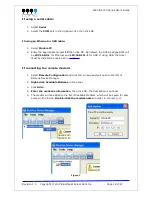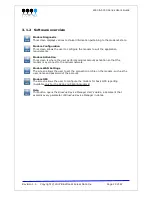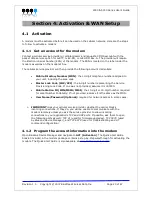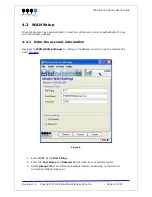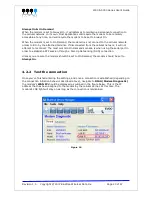
4000 & 5000 Series User’s Guide
2.2 Features
3 different data connection
interfaces
Serial/RS-232/COM, Ethernet, and USB
Autonomous & persistent
connection management
Fully integrated TCP/IP protocols allow the modem to
connect autonomously to the packet network (Internet).
This feature enables capabilities such as: in-call
diagnostic, Serial-IP, stand-alone GPS, remote
configuration and remote firmware upgrade.
Network Address
Translation (NAT)
When packets leave a LAN IP and reach the modem, it
performs NATing. The source IP of the packet is modified
to match the modem's WAN IP. When packets come back
from the WAN the modem then performs a reverse NAT.
IP pass-through
The modem can assign its WAN IP address to the attached
host, thus disabling NAT. The modem remains reachable
through its reserved TCP and UDP ports.
In-call diagnostic
The user can get modem status information while in a data
call, without interrupting the data session
Serial IP
The modem encapsulates data coming from the serial port
into a TCP or UDP packet and sends it to a remote server
on the packet network. It decapsulates IP packets coming
from the network and sends raw data to the serial port.
Remote configuration
The user can remotely configure or perform remote
diagnostics on the modem using BlueVue Device Manager
or a terminal session
Remote firmware upgrade
The user can remotely upgrade the modem’s firmware
using BlueVue Device Manager
Password protection
The modem can be protected from tampering by
requesting the user to enter a password before the
existing modem configuration can be viewed or modified
Integrated GPS Receiver
Available on the 5000 series modems only. A Trimble GPS
receiver is embedded into the modem for Automatic
Vehicle Location (AVL). The modem can report this
positioning data locally to any of the local data interfaces
(serial, Ethernet, or Ethernet-over-USB), and/or remotely
to a predefined server (see stand-alone).
Stand-alone GPS
Available on the 5000 series modems only. This feature
allows remote asset tracking by sending GPS data to a
remote server without the need for a client application
connected to the modem.
Store and Forward
This feature allows I/O and/or GPS report preservation. If
a unit loses its WAN connection, the data being collected
through I/O and/or GPS event reporting will be stored in
memory and automatically forwarded when the WAN
connection is established.
Revision 1.5
Copyright © 2007 BlueTree Wireless Data Inc. Page 8 of 67


















